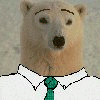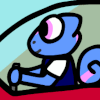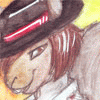
A flowchart I created once to detail the choices you have to make among alternatives to decide how therianthropic characters "fit" into your setting. Obviously I had limited space to describe the endpoints. And I think the essential tensions are rather simpler than this makes it seem.
Category Other / Miscellaneous
Species Unspecified / Any
Size 818 x 1058px
File Size 75.2 kB
Well, yes, the difference from human society is part of it. But the similarities are important too-- otherwise, we could talk about the 'society' that grains of sand have, and be just as satisfied. Instead, I see everybody doing work with anthropomorphic figures taking humanness as a key point of reference-- and the nature of various animal species too-- which works because we are, after all, animals.
Fantasy doesn't work just because it's "different," "unusual" or "makes less sense." Much the contrary, the very essence of fantasy, like other fiction, is to render a vision that's familiar to the reader.
Were it otherwise, there'd be a markets for novels in made-up alien languages, and for novels that are, start-to-finish, about things that humans could never percieve or comprehend.
I don't think I posit anything more-anthropomorphic-than-human. If your issue's with using 'anthro' or 'anthropomorphic' as short for anthropomorphic animals, well... I remind you of the context. That's how the term's used in the fandom, and that technical meaning is immediately clear from the fact that this is posted to a site dealing in therianthropic figures.
Fantasy doesn't work just because it's "different," "unusual" or "makes less sense." Much the contrary, the very essence of fantasy, like other fiction, is to render a vision that's familiar to the reader.
Were it otherwise, there'd be a markets for novels in made-up alien languages, and for novels that are, start-to-finish, about things that humans could never percieve or comprehend.
I don't think I posit anything more-anthropomorphic-than-human. If your issue's with using 'anthro' or 'anthropomorphic' as short for anthropomorphic animals, well... I remind you of the context. That's how the term's used in the fandom, and that technical meaning is immediately clear from the fact that this is posted to a site dealing in therianthropic figures.
I tend to agree, though I've also toyed with elaborate fixes to the "cannibalism" outcome.
So, what species would you pick? Mid/large carnivores with a lot of infra-genre diversity (e.g., canis and panthera) plus one or two other optimal picks among omnivores (raccoons, possibly all procyonids), are usually where I go with a very limited set of species. I mean, after all, if you just say big cats, canids, and raccoons, you've covered a *large* percentage of everybody's fursonas already.
So, what species would you pick? Mid/large carnivores with a lot of infra-genre diversity (e.g., canis and panthera) plus one or two other optimal picks among omnivores (raccoons, possibly all procyonids), are usually where I go with a very limited set of species. I mean, after all, if you just say big cats, canids, and raccoons, you've covered a *large* percentage of everybody's fursonas already.
I already have a species count made, updated in realtime. :)
http://rh.greydawn.net/mps.php
With no filtering, the top 25 species on the list account for 85% of all characters (multiply by 1.497 because the top 46 species listed don't total 100%).
However, the species can be filtered and grouped.
Toss out the non-"furry" species: Human, Blood Elf, Night Elf, Draenei, Demon, Vampire, Shapeshifter, Elf, Tauren, Troll, Hybrid, Succubus, Orc, Angel, Incubus, Drow)
Group like species (in the same way that there are human ethnicities) and calculate the percentages with excluding the above (multiply by 1.795):
* Feline (34.8%) = Feline, Neko, Tiger, Lion, Panther, Cheetah, Leopard, Snow Leopard, Lynx
* Canine (32.9%) = Wolf, Fox, Canine, Kitsune, Husky, Jackal, Hyena
* Equine (6.5%) = Equine, Unicorn
* Bovine (1.8%) = Bovine, Bull
Combine those 4 with these 10 for a total of 14 species:
* (9%) Lapine
* (5.4%) Dragon
* (1.8%) Mouse (could also include Rat or general "rodent")
* (1.8%) Squirrel
* (1.4%) Skunk
* (1.4%) Bear
* (0.9%) Raccoon
* (0.9%) Bat
* (0.9%) Otter
* (0.5%) Kangaroo
With those 14, you're alienating only the smallest percent of the anthro players (Gryphons, Phoenixes, Deer, Badger, Lemur, Pokemon, etc.).
If you eliminate the bottom 6 and stick to 8 species, then you're satisfying nearly 85% of the furry "population," which seems like a fair trade-off if you only want to work with 8 "species."
Personally, I'd probably use those 14, maybe swap Kangaroo for another winged species.
http://rh.greydawn.net/mps.php
With no filtering, the top 25 species on the list account for 85% of all characters (multiply by 1.497 because the top 46 species listed don't total 100%).
However, the species can be filtered and grouped.
Toss out the non-"furry" species: Human, Blood Elf, Night Elf, Draenei, Demon, Vampire, Shapeshifter, Elf, Tauren, Troll, Hybrid, Succubus, Orc, Angel, Incubus, Drow)
Group like species (in the same way that there are human ethnicities) and calculate the percentages with excluding the above (multiply by 1.795):
* Feline (34.8%) = Feline, Neko, Tiger, Lion, Panther, Cheetah, Leopard, Snow Leopard, Lynx
* Canine (32.9%) = Wolf, Fox, Canine, Kitsune, Husky, Jackal, Hyena
* Equine (6.5%) = Equine, Unicorn
* Bovine (1.8%) = Bovine, Bull
Combine those 4 with these 10 for a total of 14 species:
* (9%) Lapine
* (5.4%) Dragon
* (1.8%) Mouse (could also include Rat or general "rodent")
* (1.8%) Squirrel
* (1.4%) Skunk
* (1.4%) Bear
* (0.9%) Raccoon
* (0.9%) Bat
* (0.9%) Otter
* (0.5%) Kangaroo
With those 14, you're alienating only the smallest percent of the anthro players (Gryphons, Phoenixes, Deer, Badger, Lemur, Pokemon, etc.).
If you eliminate the bottom 6 and stick to 8 species, then you're satisfying nearly 85% of the furry "population," which seems like a fair trade-off if you only want to work with 8 "species."
Personally, I'd probably use those 14, maybe swap Kangaroo for another winged species.
Interesting-- that conforms in the main to counts I've obtained from Pounced.org (back when it had a stats page), and... I don't remember, some other large sample whose source eludes me ATM. Haha, maybe it was greydawn!
I'm suprised actually to see Kangaroos and Raccoon so low.
Also, considering the escalating problem you run into crossing the barrier between omnivore and herbivore, it's tempting IMO to exclude not only the bottom eight plus bovines (at less than 2% apiece), but even equids and lapines. There's such a lovely coherence to an all-mid/large carnivore setting, that it's hard to resist.
I've also toyed with the idea of a mid-large carnivore plus ONLY rodents and elephants-- as the rodents with sufficient scaling wouldn't make very likely meals, and the elephants wouldn't be very killable (if they were smart).
There's just... diminishing returns on strict herbivores that aren't intensely popular. Maybe I'm even more of an advocate of "YOU'RE MEAN" than you.
Of course, this entire thought process comes from the strong or natural model for anthropomorphism-- that such beasties can "fit" nature, at least to the degree primates do.
I'm suprised actually to see Kangaroos and Raccoon so low.
Also, considering the escalating problem you run into crossing the barrier between omnivore and herbivore, it's tempting IMO to exclude not only the bottom eight plus bovines (at less than 2% apiece), but even equids and lapines. There's such a lovely coherence to an all-mid/large carnivore setting, that it's hard to resist.
I've also toyed with the idea of a mid-large carnivore plus ONLY rodents and elephants-- as the rodents with sufficient scaling wouldn't make very likely meals, and the elephants wouldn't be very killable (if they were smart).
There's just... diminishing returns on strict herbivores that aren't intensely popular. Maybe I'm even more of an advocate of "YOU'RE MEAN" than you.
Of course, this entire thought process comes from the strong or natural model for anthropomorphism-- that such beasties can "fit" nature, at least to the degree primates do.
Well, there are insectivores to consider, too. With my Elliot scribblings, I stuck mostly to midsize ominovore or predatory critters - lemurs, foxes, raccoons wildcats, tanuki, etc - figuring they were about the same size and could therefore get along. But these weren't intended as exercizes in serious worldbuilding, just a slightly more limited version of the "OMG everyone is a furry!" type setting. When SomeoneRandom added snow leopards in a story he wrote me, I didn't call him on it because I am not passionate enough about the setting to be mean ;)
In writing stories other than intentionally silly stuff, I think I've either:
-Written an obvious sci-fi/fantasy justification for the anthro critters as special creations, so that it's widely known why they exist and they don't yet have a clearly defined moral or legal role in society;
-Had just one anthro species instead of humans, so that there's no "normal" species for the characters to compare themselves to; or
-Had two anthro species with an obvious lethal conflict between them, in an unstable situation and some mystery about how that situation arose.
So, I think that when plausibility is important, you either need to provide a good explanation, accept that the characters notice there's a big mystery, or just say that evolution took a different turn.
-Written an obvious sci-fi/fantasy justification for the anthro critters as special creations, so that it's widely known why they exist and they don't yet have a clearly defined moral or legal role in society;
-Had just one anthro species instead of humans, so that there's no "normal" species for the characters to compare themselves to; or
-Had two anthro species with an obvious lethal conflict between them, in an unstable situation and some mystery about how that situation arose.
So, I think that when plausibility is important, you either need to provide a good explanation, accept that the characters notice there's a big mystery, or just say that evolution took a different turn.
Yeah, those all sound like good choices to me.
Of course, I don't think I articulated the issue with the "Unnatural" outcome on this chart too well. At issue is really the choice between an unselfconscious animal-as-person, and the opposite, which is just "some kind of not-quite-human and their existential angst."
Not that existential angst doesn't work too-- I mean, come on, Frankinstein's Daemon. But like some other things (transformation) it just misses the mark for what I, myself, want outta the genre.
There is a whole other option not represented on this chart, which is indeed to just rely on the senses of "this is like the animal world," and "this is like how humans get along," for plausibility without trying to make them compatible or explain the details where they differ. That's essentially the lazy fantasy approach, and it does work in short stories especially. In fact, it can even be used pointedly to make the whole situation seem steadily more absurd and alarming-- kinda like in Orwell's Animal Farm.
It's just that there's this thing in my brain that commands me to understand an entire universe before I feel like I've understood what goes on on the back seat on saturday night, between young furries in love. ^_^
Of course, I don't think I articulated the issue with the "Unnatural" outcome on this chart too well. At issue is really the choice between an unselfconscious animal-as-person, and the opposite, which is just "some kind of not-quite-human and their existential angst."
Not that existential angst doesn't work too-- I mean, come on, Frankinstein's Daemon. But like some other things (transformation) it just misses the mark for what I, myself, want outta the genre.
There is a whole other option not represented on this chart, which is indeed to just rely on the senses of "this is like the animal world," and "this is like how humans get along," for plausibility without trying to make them compatible or explain the details where they differ. That's essentially the lazy fantasy approach, and it does work in short stories especially. In fact, it can even be used pointedly to make the whole situation seem steadily more absurd and alarming-- kinda like in Orwell's Animal Farm.
It's just that there's this thing in my brain that commands me to understand an entire universe before I feel like I've understood what goes on on the back seat on saturday night, between young furries in love. ^_^
"Kevin and Kell" takes that lazy approach, and leads to cannibalism. It just doesn't work as a plausible setting. As a writer I can't turn off my brain when reading a story, so I end up seeing something like "Iron Man" and coming away saying, "That was fun, but it was also stupid and I hate the characters." I generally want to see a setting where there are no gaping plausibility holes.
The game "Ironclaw" shows another possible solution. There, there's pretty much any anthro mammal species you want (and some birds), and "what do they eat?" is answered by saying that they've got various lizard species for food as well as draft animals. On your chart the verdict is "Unnatural," but since it's a medieval setting, evolution doesn't seem to have occurred to them, and any mystery can be blamed on the mysterious lost Autarch race. So, basically they're too ignorant to notice that their situation is unnatural. That at least addresses the characters' confusion.
The game "Ironclaw" shows another possible solution. There, there's pretty much any anthro mammal species you want (and some birds), and "what do they eat?" is answered by saying that they've got various lizard species for food as well as draft animals. On your chart the verdict is "Unnatural," but since it's a medieval setting, evolution doesn't seem to have occurred to them, and any mystery can be blamed on the mysterious lost Autarch race. So, basically they're too ignorant to notice that their situation is unnatural. That at least addresses the characters' confusion.

 FA+
FA+













Comments